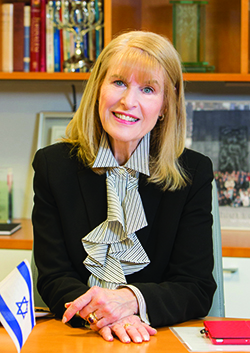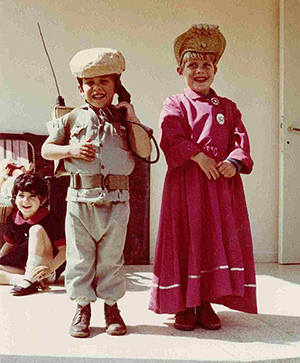Hadassah
President's Column
Purim and Jewish Geography
 Purim this year has a larger than usual footprint on the secular calendar, straddling February 28 and March 1, but for Hadassah, the imprint of the holiday is permanent, etched in our hearts and informing our view of Jewish history, destiny and service 365 days a year.
Purim this year has a larger than usual footprint on the secular calendar, straddling February 28 and March 1, but for Hadassah, the imprint of the holiday is permanent, etched in our hearts and informing our view of Jewish history, destiny and service 365 days a year.
The Women’s Zionist Organization of America was founded in the season of Purim, 1912, and our founders took their institutional name from the biblical heroine who saved her people. The role model for Jewish girls across the millennia was known in society by her Persian name, Esther. Her Hebrew name was Hadassah.
Purim joins two common themes of the Jewish saga—joy and oppression. It also reminds us that most of our holidays have not only the obvious divine dimension but also a geographic component.
Persia is the easternmost point on our biblical map. Passover takes us from Egypt, through Sinai to Israel. Shavuot and Sukkot have roots in Israel’s harvest seasons, and Hanukkah follows the path of Israel’s subjugation by the Seleucid Greek Empire—based in Syria—and its struggle to regain independence and rededicate the Temple in Jerusalem.
Purim also embodies the bedrock Zionist principle of self-determination. By the time Esther revealed Haman’s evil intent to Ahasuerus, the king had already approved the plan that would lead to wiping out the Jewish community. Since an order under royal seal could not be revoked, he issued a second order allowing Jews to arm and defend themselves.
Zionism was founded as the organized effort of the Jewish people to liberate themselves, to build a modern state and the institutions of governance, justice, self-defense and healing necessary to achieve and sustain national sovereignty.

Hadassah’s founding generation quickly distinguished itself in the Zionist movement. Less than a year after our inaugural meeting in New York we sent our first two nurses to Jerusalem. That small step made us medical pioneers, and at the height of World War I we mounted a more ambitious project. We organized and dispatched the 44-member American Zionist Medical Unit, which arrived in Palestine as fighting raged between British and Turkish forces less than 30 miles from Tel Aviv and Jerusalem. The unit became the nucleus of the Hadassah Medical Organization, which in turn built the foundations of Israel’s health care system and remains the flagship institution of Israeli medicine.
In the 1930s, Hadassah also became an integral part of rescuing Jews from Nazi-dominated Europe by taking responsibility for Youth Aliyah. After World War II, we transformed our initiative to house and educate refugee children into a program of nurturing and educating immigrant and at-risk youth.
No king or president granted Hadassah permission to engage in these activities. Like the Jews of ancient Persia, we equipped ourselves and acted. And when Israel achieved independence, instead of the new government supporting Hadassah, it was Hadassah that bequeathed to the state most of the network of more than 130 hospitals, clinics, infant welfare stations and dispensaries we had set up.
I came to Hadassah for a specific personal motive—to be part of the effort of helping Israel during the Yom Kippur War by raising funds for the Hadassah Medical Center. Once I was on the inside, I realized—and have since been inspired by the same realization many times over—that I was part of the long continuum on the map of Jewish history, from Egypt and Persia to the Land of Israel, and representing Jewish women in America.
Whether you look at a map drawn in the sands of a Middle Eastern desert or a Google app on your smartphone, Israel is still in the same place. Egypt and Iran/Persia are the largest countries in the region and still Israel’s neighbors. This is the map of our foundations and our faith—and, as Purim reminds us, the source of our greatest struggles and our greatest joy.









 Facebook
Facebook Instagram
Instagram Twitter
Twitter
Leave a Reply